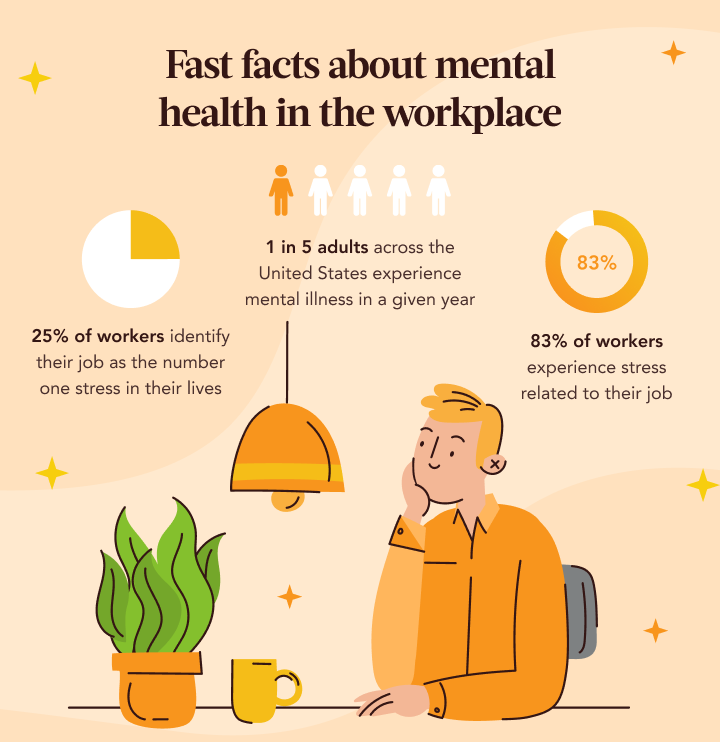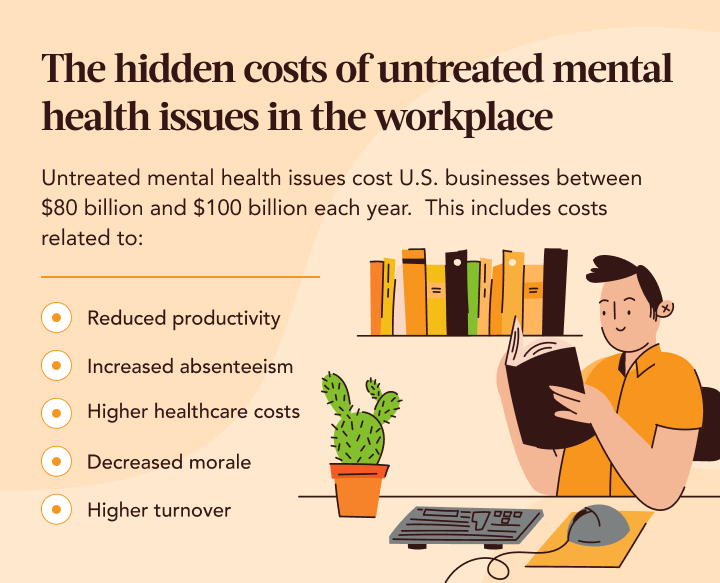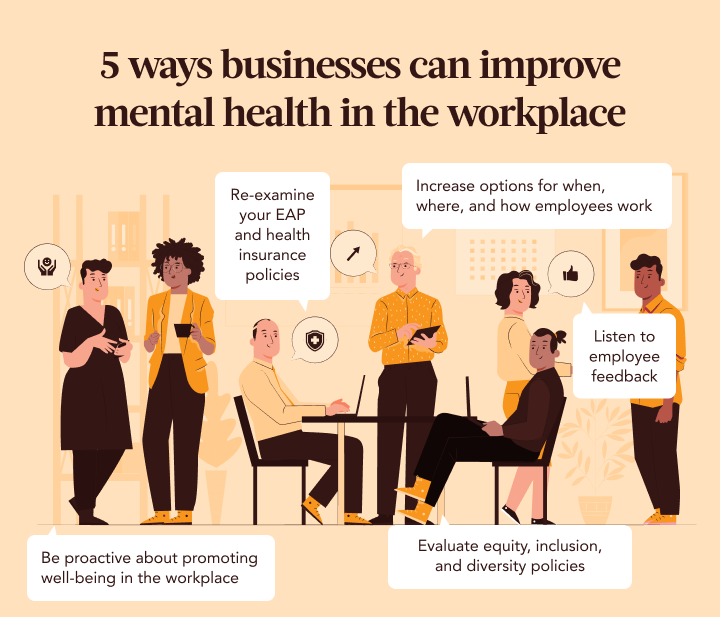5 Ways to Improve Mental Health in the Workplace

Today’s economic environment is rocky and uncertain for businesses of all kinds. While employers face a full plate of challenges across the business landscape, they may also be overlooking an important, and often neglected issue within their own workplace–employee mental health.
Mental health isn’t just an aspect of our overall well-being—it impacts every facet of our lives, including our productivity and performance in the workplace. Unfortunately, mental health issues are increasingly common in today's work environments.
According to the National Alliance on Mental Illness, approximately 1 in 5 adults across the United States experiences mental illness in a given year, with anxiety and depression being the most commonly diagnosed disorders. These issues are increasingly prevalent in the workplace, where burnout and the pressure of always-on-notifications can take a toll on employees' mental health.
In fact, the American Institute of Stress reports that job stress is the leading cause of stress in the United States, with an estimated 83% of workers experiencing stress related to their job. This stress can contribute to a range of mental health issues, from anxiety and depression to burnout and even suicidal thoughts.

The impact of mental health issues in the workplace is significant, not just for individuals but also for organizations as a whole. The World Health Organization estimates that depression and anxiety cost the global economy $1 trillion per year in lost productivity. Additionally, employees with untreated mental health issues are more likely to take time off work, have lower job satisfaction, and more frequently leave their jobs altogether.
However, there are steps organizations can take to improve mental health in the workplace. In this blog post, we will explore practical strategies for improving mental health in the workplace, from creating a positive work culture to promoting self-care and resilience. We will also discuss the benefits of prioritizing mental health throughout your business, and how doing so can lead to a more productive and positive work environment for everyone involved.
How do untreated mental health issues impact businesses?
Untreated mental health issues can have a significant negative impact on businesses. These issues may lead to reduced productivity, increased absenteeism, higher healthcare costs, greater turnover costs, and decreased employee morale, among other problems.
Here are some of the ways that untreated mental health issues can negatively impact businesses:
- Reduced productivity: Mental health issues such as depression, anxiety, and stress can significantly impact an employee's ability to focus and perform their job. This can lead to reduced productivity and missed deadlines.
- Increased absenteeism: Employees with untreated mental health issues are more likely to miss work due to illness or other reasons. This can lead to decreased productivity and increased workload for other employees.
- Higher healthcare costs: Employees with untreated mental health issues may require more medical treatment, leading to higher healthcare costs for employers.
- Decreased employee morale: When employees are struggling with mental health issues, it can lead to a decrease in morale and engagement. This can lead to higher turnover rates, and difficulty attracting and retaining top talent.
What is the cost of untreated mental illness in the workplace?
Untreated mental health and substance abuse issues cost U.S. businesses between $80 billion and $100 billion each year. This includes costs related to absenteeism, decreased productivity, increased healthcare costs, and turnover. Mental wellness in the workplace has a significant effect on businesses and the economy as a whole.
Employers have an opportunity to improve mental health in the workplace, and to provide resources and support for employees who may be struggling. By investing in employee mental health, businesses can improve productivity, reduce healthcare costs, and create a positive work environment that benefits everyone.

5 ways businesses can improve mental health in the workplace
Great mental wellness in the workplace starts with a proactive culture, and follows through with strong resources and programs that support the needs of employees. Across these domains, here are 5 key ways you can improve mental health across your workplace:
- Be proactive about promoting well-being in the workplace
It may sound simple, but taking basic steps to promote mental health and well-being in the workplace will go a long way towards creating a healthy environment. Mental wellbeing has two main components—both intrinsic and extrinsic—and a healthy culture will take both into account.
Support a positive and supportive intrinsic work culture by celebrating employee accomplishments and promoting teamwork. Recognize the importance of work-life balance, and encourage employees to take breaks and prioritize self-care.
At the same time, encourage healthy external factors, such as giving employees time to take breaks and engage in physical activity throughout the workday. Physical activity has been shown to have numerous mental health benefits, including reduced stress and improved mood.
By implementing these strategies, employers are able to organically foster a workplace culture that promotes better mental health and well-being. This can lead to increased productivity, decreased absenteeism, and a positive work environment for all.
2) Increase options for when, where, and how employees work
Another form of employee mental health support is to increase options for when, where, and how employees work. This might include offering flexible work arrangements, such as remote work, flexible schedules, and job sharing.
When a business provides employees with more control over their work environment and schedule, employees are empowered to better manage their work-life balance and reduce stress. Employers may also consider offering mental health days, which allow employees to take time off to focus on their mental health without penalty. These options can lead to increased employee satisfaction and retention, while promoting a positive and healthy work culture.
3) Listen to employee feedback
An atmosphere of open communication—where employers actively seek input from employees—promotes greater mental well being. This can be approached through regular employee surveys, town hall meetings, and one-on-one meetings with managers.
It's essential to provide a safe and non-judgmental space for employees to share their feedback and concerns. Employers can then use this feedback to make meaningful changes to improve the workplace environment and address any issues that employees may be facing. By listening to employee feedback, employers can address employee challenges directly and early, leading to increased satisfaction and reduced stress.
4) Evaluate equity, inclusion, and diversity policies
Strong equity, inclusion, and diversity policies help to ensure that all employees feel valued and supported, which can boost mental health and well-being. The next step is to put company policies into consistent action—take active steps to promote diversity and inclusion, create a culture of respect, and rapidly address any forms of discrimination or bias. Employers can also make sure to provide mental health resources and support that are accessible and culturally sensitive to all employees. By promoting equity, inclusion, and diversity, employers foster a workplace environment that is welcoming and supportive.

5) Re-examine your EAP and health insurance policies
Employee Assistance Programs (EAPs) and health insurance policies are two critical benefits that employers can offer to support the mental health of their employees. Unfortunately, many EAPs are underutilized, and/or may not offer the appropriate resources for employees to address their mental health concerns effectively.
Common issues with EAPs include limited therapeutic or counseling sessions, long wait times, and a lack of diverse mental health providers. Employers can address these issues by re-examining their EAP and health insurance policies, and investigating whether or not they offer comprehensive mental health benefits that truly meet the needs of their employees.
Where EAP coverage gaps exist, they might need to be addressed by increasing the number of counseling sessions, providing a wider range of mental health services, and offering access to culturally competent mental health professionals. Businesses should also investigate mental health employer benefits that cover therapy, medication, and other treatments that are essential to managing mental health conditions.
Employers can also work with their EAP providers to improve communication and promotion of the program to ensure employees are aware of the resources available to them. Additionally, employers can seek feedback from employees to ensure the EAP meets their needs, and make necessary adjustments.
By providing comprehensive mental health benefits, employers can help employees address their mental health concerns and improve their overall well-being, leading to a more productive and engaged workforce.
How can Frankly help?
Frankly’s EAP offers an innovative, evidence-based mental health and wellness solution that supports employees, while delivering cost savings for employers. Our offering provides employees with direct, flexible access to a comprehensive mix of mental health coaching, therapy, and psychiatry services—so that employees receive the care they need, when they need it.
Implementing Frankly’s comprehensive mental health and mindfulness program can deliver substantial value for employers, while empowering employees to thrive. Our proactive approach to engagement supports employees where they are today, and boosts utilization. To find out more, book a 15 minute demo.
